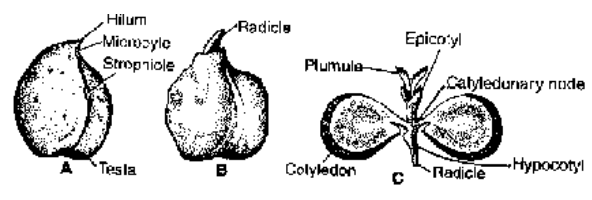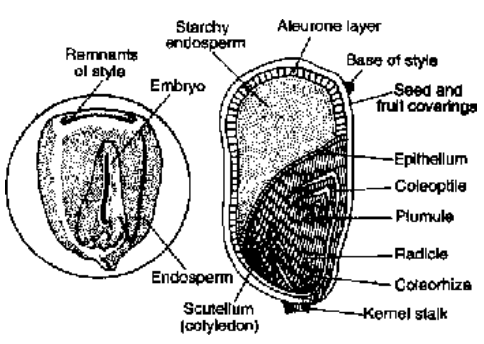
Embryo Formation (Embryogeny)
Reproduction In Flowering Plants of Class 12
It is the development of mature embryo from zygote or oospore. Development of embryo is endoscopic or on inner side due to presence of suspensor.
Embryonic Development in Dicotyledons(Crucifer/Onagrad type)
Zygote undergoes elongation and divides transversely into two unequal cells
- Suspensor Cell : It is larger basal cell which undergoes transverse divisions to form 6 to 10 celled suspensor. First cell of the suspensor (toward micropyle) is large and called haustorium. Increase in number of suspensor cells pushes the terminal embryo cell into endosperm. The last cell of suspensor toward embryo cell is known as hypophysis. It later on results into the formation of radicle.
-
Embryo Cell (Terminal Cell) :
It is present towards the antipodal side. It divides twice vertically and once transversely to produce a two-tiered 8-celled embryo.
- Epibasal (Terminal) Tier : It forms two cotyledons and a plumule. Later on, plumule gives rise to stem.
-
Hypobasal Tier (Near Suspensor) :
It produces only hypocotyl. This octant embryo undergoes periclinal division producing two layers of cells.
- Outer Layer : It will form protoderm or dermatogen for the formation of epidermis.
- Inner Layer: It will form procambium (for the formation of vascular strand i.e., stele) and ground meristem (for the formation of cortex and pith) Embryo is initially globular, undifferentiated and radially symmetrical. It is named as proembryo. Later on it develops intoembryo with the formation of radicle, plumule and cotyledons. With the growth of cotyledons, It becomes heart shaped and then assumes, the typical shape. e.g. ,m Capsella bursa-pastoris.
Embryonic Development in Monocotyledons (Sagittaria type)
The zygote divides transversely, producing a vesicular suspensor cell towards micropylar end and embryo cell towards the chalazal end. The embryo cell divides transversely again into a terminal cell and a middle cell. The terminal cell divides vertically and transversely into globular embryo. It forms a massive cotyledon and plumule. Growth of cotyledon pushes the plumule to one side. Remains of second cotyledon occur in some grasses. It is called epiblast. The single cotyledon of monocots is alled scutellum. It is shield shaped and appears terminal. The middle cell gives rise to hypocotyl and radicle. It may add a few cells to the suspensor. Both radicle and plumule develop covering sheaths called coleorhiza and coleoptile respectively. They appear to be extension of scutellum.
Polyembryony
Discovered by Leeuwenhoek in case of Citrus. It is the phenomenon of development of more than one embryo in same seed.
- Simple Polyembryony : Presence of more than one embryo sac and hence fertilisation of more than one egg. e.g. , Brassica.
- Adventitive Polyembryony : Development of embryo from nucellar or integument cell, e.g. , Citrus, Mangifera, Opuntia
-
Sexual Incompatibility :
It is the inability of certain otherwise viable gametes from the genetically specific individuals to fuse with each other and produce fertile offspring. Self incompatibility has been reported in 66 families of angiosperms. It can be morphological or physiological.
- Morphological Self Incompatibility : There are two or three mating types, viz., distyly (e.g., Primula), tristyly (e.g., Lythrum).
- Physiological Self Incompatibility : Incompatibility is due to physiology. Morphological differences are absent.
- Gametophytic Self Incompatibility : (GSI) Incompatibility in genotype of pollen e.g., Liliaceae, Solanaceae and Poaceae.
- Sporophytic Self Incompatibility : Incompatibility resides in genotype of sporophytic/stigmatic tissue e.g.,Asteraceae,Brassicaceae. It prevents pollen germination, retards pollen growth or does not allow nuclear fusion.
Seed
Morphologically, ripened ovule is known as seed. Seed can also be defined as a mature integumented megasporangium.It is a unit containing an embryo plant in which the primordia of future structures are already established and embedded in nutrient and protective tissue derived from previous generation.
Seed Coat : It is protective covering of the seed and is made up of two layers : (a) outer, called Testa, Which is usually hard, and (b) inner, called Tegmen, which is thin and papery. There is a small opening at one end of the seed coat called micropyle through which water enters. There is a depression like concavity at middle of one edge, where the seed breaks from the stalk of funiculus; this is called hilum. There is a ridge beyond the hilum opposite the micropyle. It represents the base of the funiculus which is fused with the integuments and is called raphe.
Embryo : Embryo is a young plant enclosed in a seed coat. It has two parts :
- Cotyledons : These are leaves of embryo. Their number is either one or two. Sometimes they store food materials and become fleshy. When they do not store food they remain thin and papery. The cotyledons are hinged to an axis (tigellum) at a point called cotyledonary node and open out like a book.
- Tigellum : It is the main axis of the embryo. One end of the tigellum is pointed and protrudes out of cotyledons. This lies next to mircopyle and is called radicle (rudimentary root). The other end of tigellum is the feathery plumule( first apical bud of shoot). The portion of axis lying between the cotyledonary node and plumule is called epicotyl while the portion between the node and radicle is called hypocotyl.
Endosperm : It is food-laden tissue, either present on one side of embryo or surrounding the embryo on all sides. In some seeds, the endosperm is present until maturity. Such seeds are called endospermic (albuminous) seeds. In some seeds it is consumed in young stages by the delveloping cotyledons and such seeds do not have endosperm at maturity. Such seeds are called non endospermic (ex-albuminous) seeds. All parts enclosed by seed coat are called kernel.
DICOTYLEDONOUS SEEDS
Exalbuminous Seeds (Non-endospermic seeds)
Pea seed (Pissum sativum) : Pea seeds are round. Each is attached to the placental tissue of the fruit by a stalk called funicle. The point of attachment of funicle to seed is called hilum. Near the hilum is an opening of the size of a pinhole, called micropyle. The seed is covered by seed coat which outer layer is called testa and the inner thin and delicate layer is called tegmen. Enclosed by the seed coat is present the kernel. The kernel enclose two thick cotyledons with stored food. The two cotyledons are hinged to an axis (tigellum) so that they open like a book. One end of the cotyledons lies next to the micropyle. It is radicle or rudimentary root. The protuding radicle lies under the pouch-like expansion of seed coat. The other end of the tigellum is the feathery plumule which develops into shoot. The plumule lies enclosed by two cotyledons The portion of the tigellum just below the cotyledonary node (between radicle and node) is called hypocotyl and the portion just above (between plumule and node) is called epicotyl. e.g.Gram (Cicer arietinum) Bean (Hindi – sem) (Dolichos lablab). Tamarind (Tamarindus indica) Cucurbits gourd, Cucumber, etc., are almost similar in organization.

Fig. Dicot seed
Albuminous Seeds : In these seeds food is not stored in two cotyledons, but in endosperm which is present even in mature seed and the cotyledons are thin only as food sucking organs., e.g., Castor (Ricinus communis), Papaya (Carica papaya), Cotton. These seeds are common among the monocots.
Castor Seed : The seed coat is hard shell of mottled black or brown colour. The hilum almost hidden by an outgrowth, the caruncle. Caruncle is a proliferation of tip of outer integument. It is spongy and absorbs water readily. There is a distinct raphe running longitudinally down the seed from hilum. Inside the hard seed coat, there is a white papery membrane which is a remnant of the nucellus and is called perisperm. Inside the perisperm is present a fleshy, slightly flattened, oily, oval mass of tissue, the endosperm. The endosperm encloses the embryo. The embryonic axis is called tigellum, to the central part of which are attached two thin papery cotyledons. One end of the tigellum called plumule is enclosed by two cotyledons and another end called radicle protrudes out of the cotyledons.

Fig. Monocot Seed









